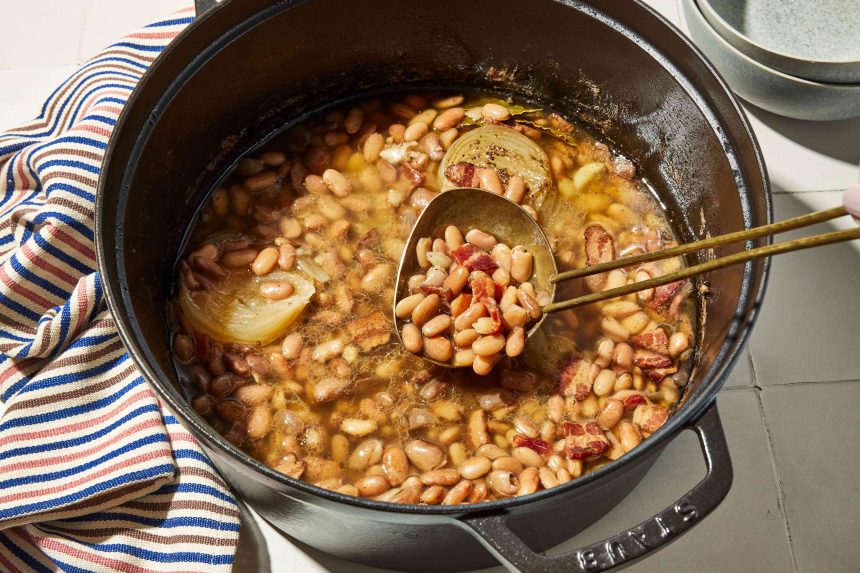We’ve all been there—you thoroughly enjoyed that pot of beans, but now you’re paying the price. Wouldn’t it be great to get to enjoy beans without the uncomfortable side effects and noisy parting gifts?
Beans are a ersatile base for a variety of dishes, but they’re notorious for causing gas and bloating thanks to their high fiber content and complex sugars. Luckily, a simple pantry staple might be able to help.
Learn more about how adding a small amount of baking soda to the soaking or cooking water has been shown to reduce gas for some people, making beans easier to digest. Bye bye, tooting!
Why Beans Cause Gas
We all know that beans produce gas, but why? The main reason is their high fiber content and unique composition of carbohydrates.
Beans contain oligosaccharides, a type of carbohydrate chain made up of simple sugars that our bodies have trouble digesting. As these oligosaccharides pass through our stomach and small intestine undigested, they eventually reach the large intestine, where gut bacteria break them down through fermentation.
A byproduct of this is hydrogen, carbon dioxide, and sometimes methane, which leads to a gas buildup, and in turn, bloating. The high fiber of beans adds to this problem, as our digestive processes fiber in the same way.
Getty Images
How Baking Soda In Beans Prevents Gas
Not to get too complicated, but sodium bicarbonate, or baking soda, is a mildly alkaline compound that can neutralize acids by releasing bicarbonate ions, raising the pH of its environment. When a small pinch of baking soda is added to the soaking or cooking liquid of beans, it can help break down the cell walls of the beans, making them easier for the body to digest.
This also helps the beans cook faster, preventing nutrient loss and preserving enzymes and compounds that aid digestion. Some enzymes involved in breaking down oligosaccharides function more effectively at a more alkaline pH. This can help the cooking liquid break down these complex sugars in the cooking process, helping us to digest them a bit more easily.
How To Use Baking Soda When Cooking Beans
To use baking soda when cooking beans, you’ll first want to measure your beans. Use no more than 1/8 to 1/4 teaspoon of baking soda for every cup of dried beans.
- Option 1: Soak the beans with baking soda: If you prefer to soak your dried beans before cooking, add the recommended amount of baking soda for your quantity of beans to cold water, covering the beans by at least 2 inches. Soak 8 hours to overnight, then drain and rinse thoroughly before cooking.
- Option 2: Cook the beans with baking soda: Place your beans in a large pot, covering them with water by about 2 inches. Add baking soda as recommended by quantity of beans, and bring to a boil. Simmer over low heat until tender. This may take 30-60 minutes for soaked beans, or 1-2 hours for unsoaked beans.
After cooking, you may want to rinse and drain the beans to eliminate any residue of baking soda, although this is optional.
More is not better
You’ll want to avoid going over the recommended quantity of baking soda when cooking beans, as too much can make them mushy and leave them with an unpleasant taste.
Is This Just An Old Wives’ Tale?
It is not fiction: Research supports the fact that baking soda can help break down oligosaccharides, the complex sugars in beans that are not easily digested and tend to cause bloating and gas. Baking soda also breaks down pectin in the cell walls of the beans, helping them soften more quickly and making them easier to digest.
Greg DuPree; Food Stylist: Ali Ramee; Prop Stylist: Hannah Greenwood
Alternatives Methods For Reducing Gas
While effective and affordable, baking soda isn’t the only way to make beans more digestible:
- Soaking: Soaking the beans in water for 8 hours or overnight can help reduce the cooking time, and remove some oligosaccharides in the process, although not as effectively as soaking with baking soda.
- Supplements: Digestive enzyme supplements (like Beano) can also help people digest beans more comfortably.
- Pressure cooking: Studies show pressure cooking can also reduce oligosaccharides in beans with its increased temperature and pressure.







